|
|
||
|
|
Select Aquatics of Erie, CO |
|
|
|
I'm New to These Fish! How are They Different? |
|
|
|
|
|
|
|
|
|
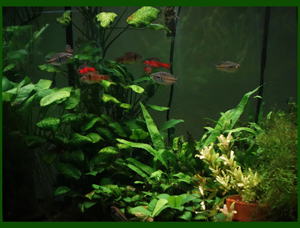 |
Contrary to what you may have heard,
successful fishkeeping, at least for the
fish carried here, comes down to keeping things
simple, consistent, and done
inexpensively. Many feel that an aquarium can be
expensive, requiring a
knowledge of
water chemistry. For the recently wild
and
rare freshwater
fish carried here, that is generally not the case.
easy
Freshwater fishkeeping as we practice it here is kept
basic, with everything
focused on frequent
feeding and maintaining top water
quality. Water changes
are done frequently, with tank
maintenance done consistently, as all tanks are
set up with easy maintenance and the health of the fish
first in mind.
The methods described here advocate cleanliness, ease
and simplicity. Tanks
do not need a thick gravel
substrate to be attractive, being easier to clean and
maintain without
it. Here we use a single layer of 1/4 inch pea gravel over half
the tank bottom, providing nitrifying bacteria area to maintain
water quality in
addition to a box, Hang-On-Back or
canister filter.
|
|
contest of best looking tanks using the
methods described below. The line of
Odessa Barbs developed here can be
seen.
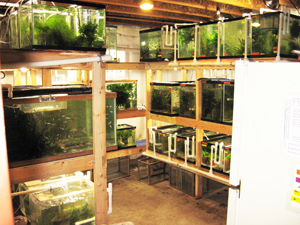
Most of what I have written here is not new, and
comes from the productive
fishrooms of the 50s to the 70s, where the commercial
strains we still see
in stores were developed. The quality of the fish sold
then, particularly with
livebearers, is rarely seen today. These methods
produce large, robust
fish, and have proven valuable as new species have come
into the hobby.
Ironically, keeping fish this way is less expensive and
simpler, with easier,
straightforward maintenance.
This is the section of the room where some of the
cooler temperature
goodeids (Below 74-75 degrees) are kept.
Notice he external loop water
changing
pvc drain setups.
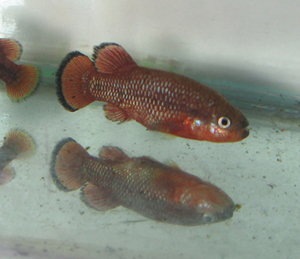
Before going into the specifics of keeping and
breeding the fish kept and bred
here, I want to address a comment I hear often hear
from customers that are
thinking of keeping the rare fish, particularly those that
cannot be found anywhere
else. On the left is a
Characodon, a red morph of C.
audax, that was developed
in Germany, and is one of the goodeids maintained by Select
Aquatics.
What I hear often from customers is:
Many of these species are
rare, slowly disappearing
from the hobby or from the wild. In fact, two species here
are currently the only
populations left in the US, and it is my intent to get these bred out and
doing well, to offer
other fishkeepers.
Hobbyists that want to make a difference, and help to keep these species
around for future
generations, have the
opportunity to do so. Those two species are the
Skiffia multipunctata (available
for sale,
email
selectaquatics@gmail.com
for availability) and the Skiffia
Black Beauty (Available soon).
I make every effort to
breed these out in large numbers, so they can be distributed. Yet
customers will sometimes
write to say that though
they would like to keep these fish, they do not want to try them. The reason given is
that
"they would just
kill them". With their being so rare, they are convinced that their
keeping these fish would only
be bad for the
fish. Currently, the Ameca splendens,
Zoogoneticus tequila and the
Characodons are critically
endangered or already
extinct in he wild. The
Xenotocas and
Skiffias are also endangered.
Granted, the actual fish you receive may have had better days as you put
forth some effort, and possibly lose a
few fish as you practice
and get your setup and husbandry dialed in, finding out what your fish
need to do their
best. But to avoid even
trying them is a mistake. These fish need for you to learn how to keep
them - Here is why:
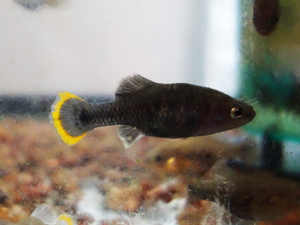
One of the fish offered here is the
Zoogoneticus tequila. One of the
rarest
fish kept here, at least 4 formal attempts to
reintroduce them to the wild
have been unsuccessful. (Fundraising for another 2017
attempt is currently in
progress) A very pretty little goodeid that breeds
easily, I first obtained
two pair about 2001. Wanting to do well with them, and
well aware of not
losing this especially hard to find fish, I set them up
in the best circumstances
I knew at the time. However, I was not the fishkeeper I
try to be today, and in
spite of my best efforts, the fish
only lasted a couple months, didn't reproduce,
and they died out. Here is what I did to eventually
keep them successfully-
Z. tequila will often become a charcoal black
with the bright yellow crescent on the tail.
Before obtaining them again, I anguished
over what I had done wrong. Today, I know that I did not have the
appreciation for their
basic needs, such as keeping them below 75 degrees, as opposed to just
setting them up
in a tank in the
coldest spot in the fishroom, and
then hoping for the best. Each issue that prevented success at
that time I have
identified today, and with this information, most customers consider the
Z. tequila to be one
of the easier species to
keep, and most do well with them. I will list below how to keep these
fish, and further
information can be found
by following the links to places in his website that deal with these
issues in greater depth,
such as the
Z. tequila species page and
Z. tequila Care Guide.
Some fishkeepers claim
that mulm - the organic debris that collects on the bottom of every
tank- is inert. They claim
it is harmless, and in
fact is good for smaller fry due to the
infusoria it will generate. In
the confined glass walls of the
aquarium, this is
incorrect. With the Z. tequila, mulm is dirt to be removed, and is bad
for the tank. A tank kept
clean of stray decaying
organic matter is a healthy tank. I also did not understand the
value of feeding more than
once per day, and routinely
feeding a live or frozen food to supplement the standard
dry food fare.
Eventually I also
realized that a 20%
water change
once a week needed to be more than doubled, to a minimum of 50% a week.
Information available to me at the time was not adequate - many
books claimed "This fish has
never been kept in
captivity", or "Little is known about the care and breeding of these
fish", and I did not understand that some of the
practices I used could
cause the fish to die over time. I got a third chance with them a
few months later, getting
fry eventually, but
changes still needed to be made as I continued to lose fish.
Eventually I learned what worked,
and made changes based on
my experience. Like most people, I tend to do everything right - but
only after trying
everything else first...
I obtained the
Z. tequila
4 times before they did well for me. Today I generally keep 100-200 on
hand, and have
distributed many hundreds
out to the hobby over the last 15 years. They are one of the hardiest
fish kept here, and
customers write that they
do well and reproduce well for them once introduced to their tanks. If I
had given up after
my first two pair that
did not do well, or did not keep trying, they would have just taken one more
step toward
disappearing entirely.
Now this sounds weird,
but as a rule these rare fish are not
rare here. I try to breed them so they are always here,
if you are first unsuccessful, and I
will support your effort as you keep them.. By
emailing me, and possibly
sending
me a pic or video of your tank, I may be able to help you out
if you are having problems. Simply email me at
selectaquatics@gmail.com,
and I generally respond to my emails within 24-48 hours.
_________________________________________________________________________________________________________
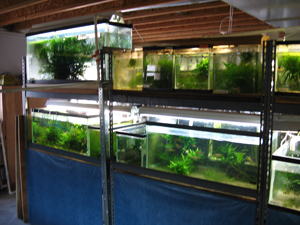
To keep any of these fish, a few basics must be in
place. These are
covered in a number of places at the website, and I
will cover them here.
For further reference, see
Fishkeeping Tips 1,
2, 6,
9,
10,
individual species
pages, Care guides,
Essays, and the Select Aquatics
video on filtration
where you see the tanks and how they are routinely kept here.
A few fundamental practices must be followed to keep
them at their most
consistent, easy to care for, so all of the fish stay in
optimal health.
Tanks can be maintained as display
focal points, or kept as attractive,
natural environments maintained
for the maximum health and breeding
of the fish, such as this group of tanks
that was used for breeding and
growing out of the rarer swordtails and
Limias.
the fish do. A fertilizer meets their needs.
That plants like dirty tanks is a myth.
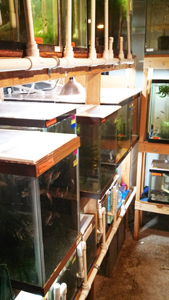
Most species carried here can be kept in 29 gallon
tanks. In addition, if
possible, another 10 gallon should be available for
females dropping young,
to raise the fry until they are old enough to be added back
in with the
adults.
Many of the fish here are good community fish, but due
to their rarity and
temperature requirements, some of the
goodeids are best
kept by themselves.
And there are two species of goodeids that are very
attractive, but can
sometimes be aggressive with tankmates. (The
Ameca
splendens, and both
populations of
Xenotoca eiseni). The
Green Dragon plecos, in contrast,
is a great community fish, though some cichlids may nip
at their flowing fins.
The Odessa barbs
and Alfaro culratus are also
excellent community fish. The
swordtails
have proven to be great community fish, though a few, such as the
X. montezumae, you may want to
keep by themselves to protect fry.
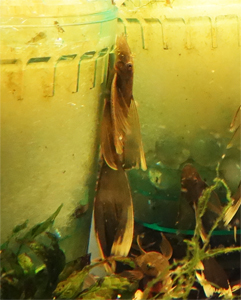
Set up the tank away from
windows or heating/cooling vents, in a place
where the temperature is consistent and closest to where
the tank needs to
be maintained. Here is a young, unsexed
Plecostomus Green Dragon.
For fish such as these that
require higher temperatures, a
heater must be
provided, and heaters are the exception to components
that are simple,
durable and inexpensive. Unfortunately, dependable
heaters can be very
expensive, and most do not last longer than 1-2 years.
Heaters are one
aspect of the hobby that have not kept pace with
improvements that have
occurred in filters, lights and the tanks themselves.
You will simply need to
check the temperature of a heated tank frequently, and
replace the heater
as necessary.
Simplicity is the key. Having control over the
variables that keep the tanks and the fish healthy is essential. Over
many
years, a broad array of
filtration, including chemical and
technological options, have become available in the hobby.
Much of that is not
necessary with these fish. What I will describe is all that is needed to
keep the fish that we work with
here.
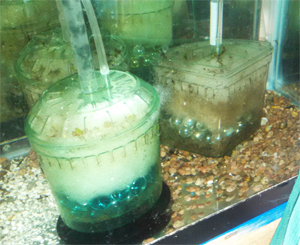
We use 4 inch air driven box filters as the basic form of
filtration in all of the tanks.
Yes, I understand that stores don't carry them anymore
and they can be unsightly.
However, few filters are as efficient, and with a 4
inch lift tube the effectiveness
of these filters is increased even further. There are over
200 box filters here, and a few
have been with me since the 1970s, and work as
well as the day they were bought.
You can see immediately how dirty the filter is, and
they are very inexpensive.
These don't use airstones, are simply constructed, and
most importantly, work to
collect the mulm within the aquarium and remove it from
the tank. They can be found
online, and they are also sold by Select Aquatics.
These, in combination with
water changes and
minimal substrate, provide all of the
water maintenance in
most of the tanks here. With a few tanks, many
canister and quality HOB (Hang
On Back) filters are often used.
Box
filters are very economical, durable,
simple and inexpensive to maintain. They are
weighted down with marbles, and
filled with polyester fiberfil that can be
found cheaply at any hobby store for
making stuffed animals, etc.
changed exactly when it should be.
Everyone wants a filter that you set up, plug in and
forget. Please, just think about that for a second... it simply isn't possible.
All need to be
cleaned regularly, otherwise all of the water in the tank must filter
through all of the waste that the filter has
collected since its last
cleaning, and it does this many times an hour. There are foam style
filtration systems with claims
they never need cleaning,
or can go for up to two years without maintenance. Amazingly, many fish
will survive in those
conditions. If you wish
to keep these rarer fish, see their
maximum size, color and
breeding,
then decaying organic matter
must be removed from the water
that the fish live in and depend upon. Live plants are also very
important to keep ahead
of the normal
release of waste into the aquarium, and provide the most comfortable
environment for the fish.
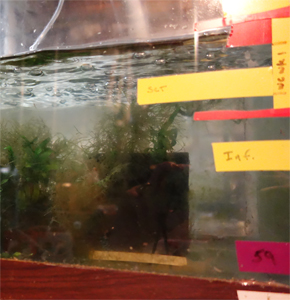
This is a tank of growing out
Odessa fry, an instance where I do use
sponge filters.
They can be used for this purpose because the water is
changed after each feeding,
and though the sponge filter keeps the
tank environment fairly funky with stray debris,
the water quality stays good from 3x per day 50% water
changes, required by the
young
Odessa fry
their first few weeks. The new fry can also feed from the surface
of the filter. Sponge filters as the sole means of
filtration, in my opinion, are not
adequate. They generally maintain a lower level of cleanliness
and allow mulm to
accumulate. We have decided here that sponge filters
alone do not provide
appropriate conditions for the maintenance of healhy,
colorful fish that live normally
and breed
as they should. Sponge filters can certainly be used with weekly
siphoning
of the tank bottom, and a thorough
cleaning of the filters in aged aquarium water,
2x per month. However, you can never tell how dirty a filter has
become when
trying to gauge the amount of
decaying organic matter in your tank.
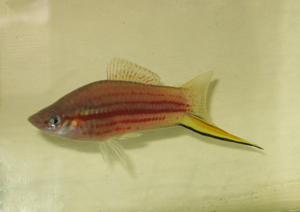
No bacterial activity that exists in your tank is
strong enough to process all
of the waste and detritus
that will collect in a normal aquarium. Many fish are quite
resilient, and some will
live for long periods in less than optimal conditions.
However, they may never
breed for you, and why would you do that to your fish?
This is an early morph
thrown by the wild Xiph. alvarezi. Though I was not able
to stabilize this exact
look over 3 years, it was from these mutations that the
Gold alvarezi was
developed. This is a healthy, happy fish.
With a eye for simplicity, your fish can
be kept in a much healthier environment at a fraction of what could be
spent,
in a tank that is easier for
you to assess, remedy and maintain, and where everything is clearly
understood with the
fewest unwanted surprises.
I have tried many types
of sponge filters in the past, and worked with them for 5 years at a
local university where I
maintained over 200 tanks- all using sponge filters. I would love to avoid cleaning 200
box filters here every month.
But there simply isn't a
short cut to effective mechanical filtration that removes mulm and
detritus.
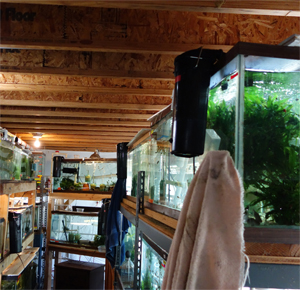
For livebearers, box or canister filters that remove
all waste from the tank
is essential, (Without sucking up fry) followed by good
quality Hang On Back
(HOB) filters, and lastly, sponge filters if they are
regularly cleaned. There
is no way to misunderstand anything about a
box
filter. Dirt goes into the
tank and then is removed. The box
filter fills up, you then dump the
polyester floss (found cheaply at any
hobby store) - marbles are used
to weigh them down. Charcoal is not used here. The box filter only
fits together one way, and is powered by air from
a nearby air source
(air pump, blower etc.) Simple and efficient. One in a
10 gallon, 2 in 20s,
30s and 40s, 3 in 55s, 4 in 100s. Also see
FT
Filtration, and the Filtration Video.
Those tanks that are fed beans for
the
Green Dragon Plecos
will often require
an HOB filter to assist the box filters in removing any mulm,
while maintaining
water quality. (Pic
left)
Spending money to purchase convenience and
hopefully, consistency (as long as the equipment works),
unforunately can remove you from the most
invasive day to day care of the fish, and I have visited some incredible
fishrooms with many
thousands of dollars spent on extensive equipment. However, the further
you distance yourself
by using controllers,
monitors and automatic systems, the less accustomed you become to spotting and diagnosing
issues that could cause
problems for you. You must recognize and diagnose all issues, then fix
them with your
knowledge
gained from doing the work yourself. Your fish should be accustomed to
getting up close and personal
with your
forearm occasionally, as you tinker and learn about the tank by working
with it and trying ideas, based on
your developing knowledge
and routine assessments of the health of your fish.
I would imagine this can
be compared to the pilot that depends upon auto-pilot systems to fly a
plane. When
those are taken away or
fail, and the plane is to stay in the air, the pilot needs to understand
how the plane works
to be able to fly it. Simplicity, cleanliness, and consistency in an attractive tank,
with the healthiest, happiest fish
can be created and
maintained by anyone.
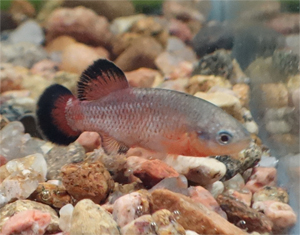
With these livebearers, particularly the
rare ones, you need to know
all you can find about the what the fish needs. (Is
the temp right?
Is aeration where it should be? Is this the correct amount
of light for
the fish and the
plants I have chosen? What is the preferred pH?
hardness? Diet?)
Many of those questions dictate what should be
bought and how it should be used with your fish. All of
that is provided for
for all of the fish
here, and I am always available to answer emails.
This is a male Characodon lateralis, Puente Pino
Suarez, a population
discovered and collected about 2012. They
require a consistently
maintained aquarium environment with good water
quality.
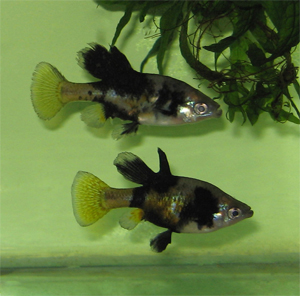
This fish was nearly lost here due to their tank
being covered, and it is
slowly coming back, but over the 3 years to get them
going again, they have
nearly been lost to the hobby in the US. This is the
Skiffia multipunctata.
Check the
Home Page for
availability.
This is he
original line. Those currently sold are the same population, but the
black sploching on he current fish is not as extensive.
For the fish you care about, choose your setup through
knowing what everything
does, and how everything works. With
these rare fish, you are providing them
a future on
this planet, and they are not just for our own temporary enjoyment-
The fact that they are beautiful and entertaining as
well is all extra benefit!
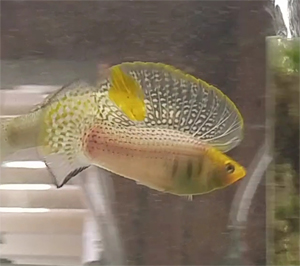
Possibly the most entertaining and beautiful of
the livebearers is the Poecilia
velifera, the Yucatan Sailfin Molly. However, they need
to be fed frequently,
and have heightened filtration and
water changing
needs. See the essay on
keeping the velifera molly
HERE.
The "secret" to a successful, healthy tank is
consistency at keeping the water quality where the fish do
their best.
They will thrive and
breed most naturally in an environment that can be easily maintained
(and thus consistent).
This means that the few
variables that most directly affect the survival of your fish are right
at your fingertips.
This way, problems can
then be
spotted and resolved quickly.
Many of the species here require these husbandry techniques (The
Skiffias, Characodons, Limias, Velifera, etc.),
but any fish you keep - Cichlids, catfish, Killiefish, etc. will all do
their best when raised with these approaches.
Hardier, established pet store fish will breed even more readily,
and will reach size and color that is not often
seen using these techniques..
Your aquarium is a finite glass box filled with water
that accepts a steady flow of wastes, primarily through the
respiration of the fish,
the solid and liquid wastes of digestion,
deteriorating organic matter from uneaten food
and plant
material, and the wastes of other organisms sharing the aquarium, such as snails.
All of this waste is
dynamic, in that it actively deteriorates and is processed by bacteria, releasing
ammonia and its
by-products of nitrate
and nitrite. Filtration helps remove
solid matter, and slows the water deterioration by doing
so, but water quality
will continue to decline. When water conditions
are poor - and you cannot always tell just by
looking at it- overall
health of the fish declines. The fish must work to protect themselves from
opportunistic infections,
parasites and diseases that prey on fish with compromised immune
systems, a situation
that results from
the fish fighing an unhealthy environment. This is the primary way that
diseases get started in a tank.
When a tank is in
poor shape, the energies of the fish that would normally go into growth and
reproduction now must focus
on keeping the fish
healthy and disease free, energies that should be going into
growth and breeding. For a fish, poor
conditions are basic
stress, and stress results in poor health and a shortened lifespan. Though a quick 50% water
change can turn around an immediate
water quality problem short term, the
organic material will continue to accumulate
until
appropriate filtration gets ahead of it. This can be avoided through
doing a few things during your
initial set up,
choosing the proper filtration, and through a plan of simple, regular
aquarium
maintenance.
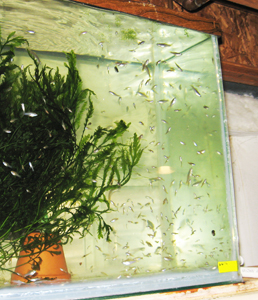
The success of your aquarium comes down to knowing
how much organic
waste is going into your aquarium, and how it is being
removed. Getting a
mental handle on this dictates how the tank should be
set up. From the start,
you can set up your tank so that it can handle the
predicted amount of waste,
through the number and size of the fish you choose to
keep, the size tank,
the filtration to be used, the
water change schedule to
be followed and the
amount and type of feeding.
This is a grow out tank of young
X. helleri Rio Otapas.
The main ways to keep ahead of the waste produced is
to:
1. Keep the number of
fish in the tank to a healthy minimum. More fish, more waste. Bigger
fish, more waste.
Fewer fish, more space,
less waste and healthier fish.
2. Doing regular
water
changes. Topping off the tank as it evaporates actually increases the
waste by
concentrating toxins over
time. So you need to do water changes, removing water from the aquarium,
generally
done once or twice weekly
of 40 - 100% per week, depending on species. All fish benefit from large
water
changes, and some require
larger changes than others. The
swords or
plecos will handle 30% weekly water
changes, while the velifera or
Characodons do best with
30-50% water changes once, or
better, twice per week.
With an automatic water change system or access to unlimited changes,
15% per day is the maximum daily
water change amount when using untreated tap water. When using aged or
seasoned water for water changes,
the amount of change is unlimited with an established single layer of
gravel on the tank bottom and appropriate
filtration.
3.
Feed appropriately.
Choose a fresh, quality dry food to ensure they are a getting a
nutritious balance of
what they need. Supplement
this with 2-7x per week additional feedings of
live or frozen foods.
Observe the
dry food you use- foods
that collect and mold up easily or leave behind mulm on the tank bottom
should be
avoided. Better quality
foods do not do this. If your dry food has no smell, it is likely too
old for much benefit.
4. Provide adequate or
greater filtration with active aeration. We use the
box filters
here, but most
adequately maintained HOB
(Hang On Back) or canister filters should also be adequate. As long as
fry
are
not sucked in to the
filter, or fish are forced to fight the current from the
filter, strong filtration and moderate
aeration is
fine. Also see the video on filtration
to gauge how filtration and aeration are done here.
Other means to improve
water quality include using live
plants, and to set up the tank
bare
bottom, with a
single layer of 1/4 inch
pea gravel over 1/3 - 1/2 of the aquarium bottom. All of the tanks here
are set up
this way. Ensure no areas
of the tank can store or accumulate mulm or debris.
The reason for the single
layer of pea gravel is two fold. The pea gravel provides substantial
extra surface
area for the colonization
of nitrifying bacteria, providing consistent, stable
biological
filtration that is
essential for appropriate
water quality, and that a frequently cleaned filter will not provide.
The thin layer of
gravel also provides a more natural looking
bottom for both the viewer and the fish. Ofen, a cloudy bare bottom
tank will clear up in 3-4 days when a single layer of gravel is added
over half the tank bottom by providing
needed nitrifying bacteria.
While this is going on,
the pea gravel is at a low enough amount that it will anchor very little
detritus / mulm,
which can be easily
siphoned away as it accumulates, before it can negatively affect the water
quality of
the
tank through its deterioration..
In pet shops, you will see tanks with
a layer of gravel of up to an inch
thick often covering the bottom, with
rockwork
or tank decorations
sitting upon the gravel for a pleasing look, or an effort to
create a natural looking environment.
The issue is that problem
areas develop in places where there in
minimal water or air circulation. Tanks set up
that way will
thrive for a fair period of time with adequate mechanical and biological
filtration. This is in part
because they are stocked
with long established hobby lines of fish that have adapted and become
tolerant of a
wide variety of aquarium conditions
and water quality.
The
fish carried here
have often only been collected from the wild recently, and are not at
their best in a tank kept
with those common
practices. As well, livebearers, as a rule, require relatively clean
conditions with healthy filtration,
frequent feeding,
aeration, and water movement.
A tank
bottom covered with 1 inch of gravel will collect waste that leaches
into the gravel beneath it. If he substrate
is not
routinely siphoned and cleaned (at least 2x monthly), ammonia then rises
up into the aquarium. Even with
gravel cleaning,
pockets of waste and mulm still escape detection, leaving the tank in a
much less healthy state
than you think it is.
Your commercial black skirt tetras or silver dollars may not notice, but
the
Xiphophorus monezumaes or the
Tiger limias certainly will.
This doesn't mean extra
effort, it just means setting up
the tank initially with maintenance in mind. When the tank is set
up with a thick layer of
gravel, or worse, a layer of soil or peat, mulm accumulates and clogs the substrate, restricting
the flow of water and
oxygen. Bacterial pockets are created that become anaerobic,
where. bacterial activity continues,
but
does not need oxygen. This produces hydrogen sulfide gas, better known
as the "rotten egg" smell we recognize
when cleaning a dirty tank. This is toxic to the fish. A simple flat
rock sitting on a layer of gravel will create an anaerobic
area beneath it if not vacuumed
effectively. Soil in a tank is for a different type of tank setup, where
plants are the primary
or sole focus of the
tank's function.
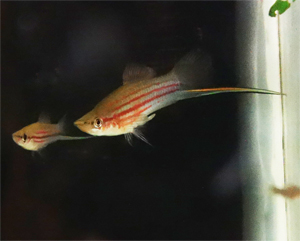
The Xiphophorus mayae was only formally
identified in 2002. The "Tiger" Limia
has just been identified and is awaiting announcement
of its scientific name.
The Xiphophorus helleri Rio Otapa was first collected
for the hobby in 2011.
The Characodon lateralis Puente Pino
Suarez was only
discovered in 2012.
Not at all fragile, these species are doing well here,
the Tigers for over 10
years. Many young hobbyists have shown that these can
be kept by anyone,
they simply need to be maintained in relatively simple, consistent
conditions.
The "Tiger Limia" was first
collected by Dominic Isla in 1999, brought back and
found to be a new species. It is in the process of
being formally identified, and
when its formal Latin name is determined an
announcement will be posted on
the Home Page. The basic
paperwork has been submitted, and with the
addition of data still to arrive from Haiti (They are from Lake Miragoane)
an
announcement should be made in the next couple months.
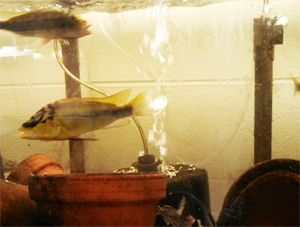
I have had customers question my opinion of
undergravel filters, still commonly
sold in most pet stores. Customers tell me
that they have kept tanks since
they were a kid, and they always worked great. There
are many reasons I do not
advocate using undergravel filters, beginning with the fact
that these are not the
commercially produced fish of 40
years ago.
The undergravel filter
revolutionized the hobby when were first invented in 1955.
Those filters literally made it possible for the
average hobbyist to keep an
aquarium in the home. I had kept tanks with undergravels
for many years, and
some of my most ambitious landscape tanks were done with undergravel filters.
uplift tubes clearly visible. Notice the
sponge filter as the air flow no longer works
properly. This is a common problem.
A filter that works by keeping all of the
waste that ever enters into an aquarium within the tank, held and stored
by
a thick layer of gravel,
reflects back to an era when the importance of
water quality was not
understood. For the
average hobbyist, breeding the livebearers or a pair of
angelfish was a fair accomplishment. The mechanics of the
nitrogen cycle were not well known (the species of
bacteria involved were only identified recently. For many years,
a species of soil based bacteria were thought to be
responsible, and this was incorrect.) Essentially, keeping and
breeding many of the specialty fish available today requires a type of
tank maintenance and
filtration consistency
that was not common 30
years ago. This attention to the needs of the fish was not considered
60 years ago, when
undergravel filters first came on the scene.
______________________________________________________________________
There is another way to look at this. As the fish do well, you will
develop an
awareness that highlights the problems
with less appropriate
options,
such as undergravel filters, and this new knowledge will apply to any
type of filtration
or maintenance tools you
choose to use with your tank.
With an:
1. Understanding of the
amount of organic material going into the tank,
2. An understanding of
the overall cleanliness of the tank based on your knowledge of how often
the single layer of
pea gravel is siphoned and the filters are cleaned, and
3. How often the water is
changed, while paying attention to water quality and clarity,
you are now in near total control of the variables that will keep that tank healthy.
There is no such thing as
a fully "self sustaining" biological environment- where you set it up and
magical biological
processes keep everything
balanced in this confined, many gallon glass box, with little concern for
what we put into it.
Efforts along those lines
simply will not support these riverine, moving water type fish.
As a competent fishkeeper,
you do not want to buy a bunch of equipment, then watch as barely
understood
mechanical devices
somehow take care of waste and the normal operation of your tank. When
the tank eventually
needs attention, and it will, or there is a crisis, you may not possess the hands on
experience and confidence
to fully understand and
fix the issue you are faced with.
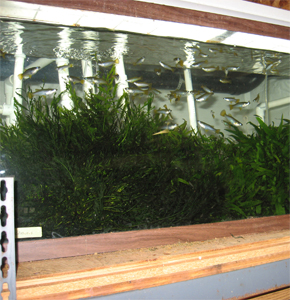
This is the great thing about
keeping a tank with special fish that are not well
known. There is the constant
opportunity to observe and learn, and the less
you depend on equipment you do not understand, the more
successful you
will be. I am
not talking about learning water chemistry or more advanced
biological concepts. Over time
certain things makes sense, some things
you do work well, and you will then have good outcomes.
You then remember those things.
I also read
all that I can
on the fish I keep.
And it's OK to make mistakes,
as long as you learn from them and make
changes from the experience. (See
Z. tequila section above)
To the left is a tank of adult
Alfaro cultratus over a bed of
Bolbitis and
Java ferns.
The best maintained tank
will run into husbandry changes as the fish grow, as the amount of
waste going into
the tank increases. If
the fish breed, the tank becomes more
stressed as the tank passes appropriate stocking
levels. For most aquarists, when a tank starts to have issues, it is generally
due to those types of developing
stresses that
are missed or not addressed.
Keeping ahead of normal growth and changes of your fish, particularly
with livebearers, as they can be prolific,
will keep you busy
enough. Creating extra maintenance issues should be avoided, through
simple and easy to
maintain tank
setup strategies and choice of filtration.
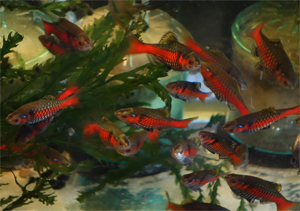
Here, the tanks are set up so that we are in
control of the water quality and
filtration, and
rarely is there ever a problem. When something does occur -
tanks here will occasionally
cloud up due to overfeeding or
stocking levels
getting too high, and this is seen and fixed
quickly. The fish are healthy
enough that when there is a problem, I am able to
address it before it
becomes an issue for them.
barbs, kept and bred here for over 6
years.
Should A Tank Be Covered?
With
some of these fish, whether a tank should be covered has become an
important consideration. A tank
being covered is
more than whether a fish is a jumper or not. Where many pet shop fish do
not seem to
even notice whether
their
tank is covered, and do not seem affected one way or the other, some of
the fish
here will not do as well
when the surface of the water has a glass or plastic top over it,
restricting air movement
and open air exchange at
the surface.
Many fish have been lost bearing this out. The fish affected are the two
Skiffias and the Characodons,
which do poorly over time
when their tank is covered, all other factors being equal. Some of the
fish that
have come into the hobby
recently have husbandry needs that have never been an issue with pet
shop fish
in the past. This seems
to be one of those issues.
Otherwise, as a rule, all of our tanks are covered, to prevent the occasional jumper and to control humidity.
Is Light Necessary?
Aside from helping to maintain your
plants,
low to moderate light is
needed to help maintain the operation
of normal
bacterial activity. Some aquarists keep their fish lights on 24/7,
particularly when raising fry that
must
grow as quickly as possible. (The
Odessa fry
here are often raised their first month with the light on 24/7.)
As well, you must always be able to see your fish- fish
that aren't watched rarely do well!
Foods
Food quality is very
important for all fish. You do not want to be someone that spends
hundreds of dollars for tanks,
stands and equipment, to
feed your fish expired stuff from the local pet store because he
sells it to you cheaply.
Dry food left open in a
humid fishroom is barely good for about 90 days. Sealed at room
temperature, it will be good
for a little longer.
Refrigerated and sealed I'd say a year. Frozen, 2 years. Making an
effort to provide better and varied
foods can make or break
the health and breeding of your fish.
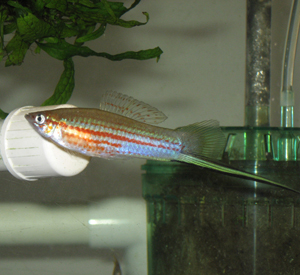
Each species of fish you keep will have
specific needs. Knowing a little
about what
each fish you keep prefers will lead toward longer lives, better
health and possible
breeding. Livebearers
are active, high energy fish that
require a
diet that contains a high quality protein component, but they also
must be fed a strong vegetable component in their diet. Some of the
goodeids,
such as the
Ameca splendens,
prefer a primarily vegetable based diet (but must
also be fed a protein food regularly), whereas other goodeids, such as
the
Characodons, prefer a high protein
component in their diet, but must be fed a
vegetable based food as well. The P. velifera will choose a vegetable
food
over a protein food when given a
choice, but must receive a protein food at
least once a
day.
This alvarezi swordtail
is higher energy, and needs a protein component in their
daily diet, as well a regular vegetable flake to meet
their grazing and vegetable
needs. Coming from flowing streams, they also require
moderate aeration
and good filtration.
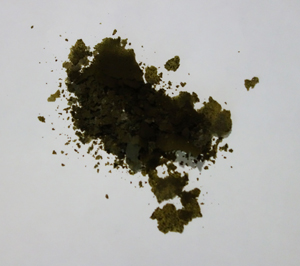
When choosing a vegetable based flake, it is not necessary to go with a
pure
spirulina flake. Go with a good quality, fortified
vegetable flake, I use a vegetable
flake offered through Jehmco online. And interestingly,
the fortified flakes are
less expensive than the pure spirulina flake.
For those looking to raise their own
live
foods, you are looking for a live food that isn't difficult, has the
greatest odds
of doing well, is nutritious, and provides high yields.
The thinking is that you want a food that "doesn't bite, fly, smell or
get away".
Every live food comes with pros and cons. Each has
some issue. Following will be which are worth the effort, and for the
fishroom here, which are not. I will list the pros and
cons of each so that you can decide which will be the best for you -
what
you are willing to work with, your schedule, etc. Also
see FT3,
FT4, FT5,
Essay- Live Foods. The foods listed below
will be
listed starting with the easiest and most nutritious.
Newly hatched baby brine shrimp is simply the easiest
and most nutritious live food for all young fish. Each batch can be
hatched in 24-36 hours at 75 degrees,
and once fed, there are no cultures or long term maintenance to be
concerned with.
The issue with feeding BBS is expense.
Many pet shops carry the brine shrimp cysts (they aren't really eggs) in
little 2 oz.
vials for often as much as $10-12. They
are bought rarely from the store, and should be refrigerated. After hanging
on a
display board for a long period at room
temperature, the hatch rate,
when you finally try to raise them, is extremely low.
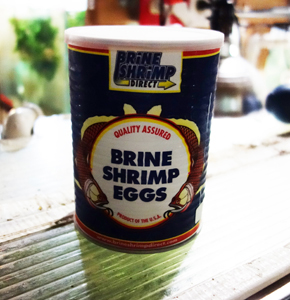
The only real way to purchase brine shrimp cysts is
to buy 1 lb. cans from an
established, consistent source such as
www.brineshrimpdirect.com. If you buy
from an individual that is working as a middle man, be
sure they were stored
properly. They
cannot be allowed to get too warm. A 1 lb. can fluctuates in price
depending on
seasonal availability, and generally runs $40-60. If possible,
always buy at
least 80% hatch rate to get the best return for your money.
A pound can of
cysts will last you a long time, and after opened, use the
plastic top
provided and keep the can refrigerated. That can will produce
hatches for
years.
For how to hatch the brine shrimp, and build a BBS hatcher, click HERE.
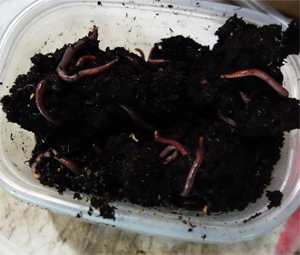
By far the easiest to
maintain long term with the greatest yield. These are
your standard smaller fishing worm available at bait
shops and pet shops, not
the larger nightcrawlers. (most of the bigger chain pet
shops have them, but for
some reason you often have to ask, or they are stored
in the refrigerator with the
packaged foods.) They are considered to be possibly the most nutritious live
food available for tropical fish. Feeding
red worms
increases breeding frequency
and the size of broods with the livebearers, and they
can be fed exclusively to
fish with all nutritional needs met.
Empty the container of purchased
red worms into a 6-12 inch deep,
covered
container of moist Canadian peat, and with daily
feeding you will be able to
harvest from the bin in about 90 days, and they will
double their numbers about
every 90 days. Be sure to drill numerous small holes in
the top to provide
adequate air
circulation.
bought from a local pet or bait shop
reproduce quickly enough to harvest
regularly in about 3-4 months.
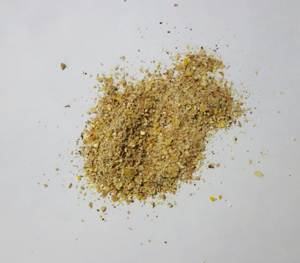
They are fed ground
chicken feed, usually the higher
protein, higher calcium
egg layer mix, which can be bought very cheaply at any
agricultural feed store.
Stores will occasionally sell it by the pound when a
bag has been damaged,
but generally it is sold in 40 or 50 lb. bags for under
$10. When bought
as a crumble, you will need to grind it up into a
powder to feed the worms,
so if possible, buy the style food that is already ground up.
You can also buy a pellet type, but that is really
tough on the food processor!
Sprinkle the food over the top of the peat daily,
making sure the food is entirely
consumed when more is added. It doesn't mold,
there is no smell, and you
simply reach in to take out the worms you need.
The red worms can also be maintained as "compost
worms" - they are the same worm, feeding on garbage and such, but
of course, that is generally done outdoors due to the
smell and size of most compost piles. Feeding the
chicken feed is
clean, neat, doesn't smell and provides a quick, convenient,
immediate source of a high quality
live food at nearly no cost,
and can be raised indoors. The worms usually clean the
surface of food thoroughly every day, so there is no rotting, waste
or deteriorating organic material that will mold or fester.
A firmly fitting top with drilled air holes keeps them confined.
The downside (and this is
a deal breaker for some) is that they generally need to be chopped up to
be fed to the size fish
most of us keep. Rinse thoroughly before and after
being chopped to remove any dirt and fine particulates that will cloud
the water. There are "grinders" available online for
cutting up the worms, but here we chop them up quickly on a plastic
cutting board with a one sided razor blade. Recently we
have been rinsing the live worms, then freezing them. They are
then thawed out and chopped up when needed. Its full
nutritional value may be slightly compromised, but it is a much more
pleasant option than processing the live worms.
These frozen foods are
the next best option,
before continuing with other live foods:
Frozen
adult Brine shrimp, Bloodworms,
Blackworms,
Daphnia and mysis are all
available as frozen foods at most pet stores,
and are a big improvement over
dry foods. The downside
is expense, and there are ways to get around the expense. Many
feed flats of frozen foods routinely, and the $20 cost of the 16 oz. flats sold in
the chain pet stores can be cut substantially
with a little effort.
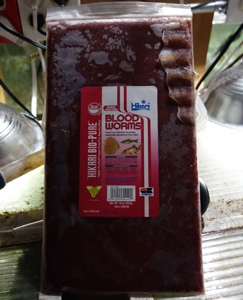
The first way around the expense is to order
online, which should be done
during the colder winter months. The $20 flats at the
large chain stores can
be bought for about $10-12. You will be charged a fee
for shipping, and
depending on he time of year you
order, you may also need to pay for
dry ice. You can get around this by
putting an order together with friends,
and you can then split up the shipping cost. he box is
then sent to you,
and the
others pick up their portions of the order.
This is not to cut out the local fish
stores - there is another way that I use more
often, and that can be done through the smaller
independent fish stores.
I tried this with a few of
the larger chain stores, and received a strong negative
response, as
individual customer care is not their focus. But with a small fish
store, you can often work out a deal that is a win for
both of you. Here is how it's
done:
You can avoid paying the shipping cost and
still buy the flats at the online price. The way to do this (and this is
the way
I obtain my flats), is to frequent a local fish
store and get to know the owner. I then go online and figure out my per
flat
cost if I order them online, including my
shipping cost. Sold for $10-11 a flat (recent price on flats of
bloodworms
bought recently), and my cost goes up to $13-14 each when
shipping is added. Then I go to the independent pet store,
and ask if
they will add an order for me on to their regular order of frozen foods.
They are paying about $7-9 a flat,
depending on
their agreements with their vendor, and are often happy to do this for
you for as little as $12-13 a flat.
I try to order at least 10
flats at a time to make it worth their while, and it becomes a win-win
all the way around, and you
are supporting the local
fish store. Then, of course, I shop there first when I need an item for
my fishroom. The fish store
makes $4-6 per flat from
you, and you are saving $6-7 per flat from the standard national chain
store price.
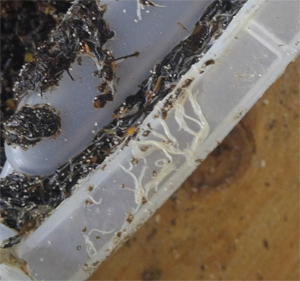
White Worms
These are kept by many
aquarists, and after numerous efforts with varying
success, I stopped keeping them due to their need to be
kept cool, and difficulty
raising them in large enough numbers to harvest
consistently, and in quantities
sufficient
for this larger fishroom.
However, we recently began using an organic
chicken
feed for the red worms,
and within this food was introduced a species of white
worm that is prolific
and is eagerly eaten by the species of fish that
normally love white worms.
They do not need to be kept cool, and they do well
being fed the same chicken
feed the red worms eat. We now are culturing them in
tubs and feeding them
daily to the Synodontis, Characodons and
P. velifera here, and have
had no issues.
Customers are now raising
them on standard white worm foods, such as oatmeal,
baby food, and moist bread. To obtain this species of
White Worm, click HERE.
with a moist paper towel rinsed in
aquarium water.
with a generous supply of chicken feed (and info on obtaining more) can be sent to you for $10 + $9 Shipping.
Simply email selectaquatics@gmail.com for more information.
Daphnia are generally not an easy
live food to
culture. Wild strains seem to crash
easily, and much of the difficulty lies in our desire
to keep them indoors or raising
them in smaller containers. Often, you may be able to
get them going, but raising
enough to feed your fish as you would like can be
difficult. However, there is a
large, red magna strain of daphnia- the Red Moscows,
that are hardy, prolific and
can be easy to maintain. These are the same daphnia
raised and distributed
through the hobby by Jim Langhammer. They are raised
here in 100 gallon horse
troughs, and though they freeze solid each winter, 2016
was the 9th year that they
have returned in the spring.
When temperatures are between 60-75 degrees, and the
daphnia are in good
shape here, with overnight delivery, a starter culture
can be sent to you for just
$10 + shipping. The mix to feed them can be found
HERE. They are fed yeast
every other day, and a special mix
made at home is fed every other day.
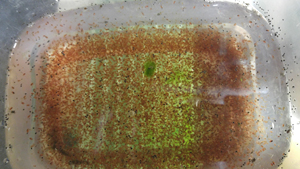
and less hardy species that need the
boost that live foods provide. With 3
100 gallon troughs going, this is about
the maximum I can feed daily when the
daphnia are doing well in the early
summer.
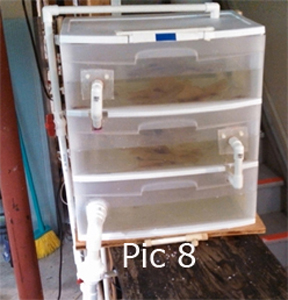
Often sold in tropical
fish stores, live cultures can be bought and reinvigorated
through proper care and feeding. Those received from
stores are generally not fed,
and can be in rough shape when first obtained. How to do
this can be found HERE.
Once fattened up, they can then
be maintained long term. they do not need to
be refrigerated, and can be
maintained and cultured indefinitely in an aquarium.
The downside is that their
reproduction is fairly slow, and raising enough to
harvest regularly can be
difficult. They can also be ordered by the pound online,
which works well when shipping
occurs in cooler temperatures.
At left is a
Blackworm culturing setup I used in my
room for a number of years.
How to build this is
HERE. Though great for
having worms available for specific
breeding projects, productivity was not enough to
justify the effort required with
this setup.
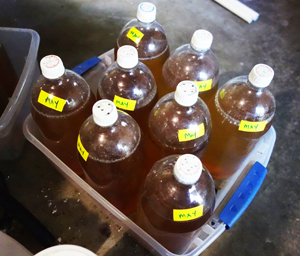
Very easy to maintain -
they require no care at all - prolific and nutritious, these
are maintained as a first food following infusoria for egg
layer fry, and livebearer fry
will eat them as well. The only maintenance is that the
new cultures must be started
about every 4-5 months, or the old culture will die out.
The issue with this live food
is that the "eels" are very small, and are generally
ignored by fish larger than about
3/4ths of an inch. How to set up a vinegar eel culture
can be found HERE. Vinegar
eel cultures are also available for $10 when they are in
good shape here, write
selectaquatics@gmail.com for availability.
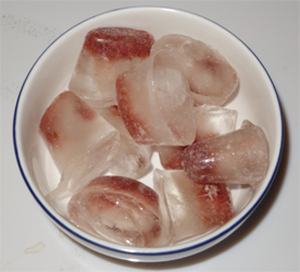
Long prepared by breeders of discus and other Cichlids, beefheart has
also
been used to put size on livebearers,
improve color and increase the size
of broods. The improvement in color when the
livebearers are fed beefheart
can be dramatic. Preparing beefheart is not
difficult, but it can be time
consuming and messy, and often the beefheart must
be special ordered at
your local grocery store. But it is an
inexpensive, high quality food that is eaten
eagerly by most fish. How to prepare it for your
fish can be found HERE. The
Characodons
in particular benefit from beefheart, and it dramatically improves
their red color.
|
Microworms: Kept for feeding the same size fish that are fed the vinegar eels, these have been kept here in the past. They were only used briefly as the yeast based medium being used caused a fruit fly problem. Many aquarists swear by them, and they can be cultured in a variety of different culture mediums. An excellent food, I just need to find a better medium. At the moment, we are using vinegar eels for newly hatched egg layer fry. Welter worms, Grindal worms, banana worms, etc. All good foods, it is up to you as a hobbyists to decide, by keeping each of them for a period of time, which best fit what you are able to do. We do not currently keep any of these here. Fruit flies: Get the wingless type. These are best fed to surface feeding insect eaters - the Alfaro cultratus feeds on similar foods in the wild, and we have raised them for those types of fish. Special culture mediums, hatching containers and flies can be found online easily. They are fed routinely by those that keep dart frogs and various species of reptiles. Due to the materials required and the type of maintenance they require, and the few fish here that would benefit, they are not currently kept here. Mosquito larvae: I include this because I have known people that have set up enclosed outdoor enclosures to raise and harvest mosquito larvae. In both cases the result produced unpleasant, but entertaining stories of mosquitos throughout their homes, spouses threatening to leave, etc. These are the nightmare food. Or so I have been told. |
|
|
So I've bred up a bunch of rare fish... now what?
You want to
share the fish you have bred out to
the hobby, so that others can keep
and distribute them as well. These fish will never be seen
in pet stores. Fortunately,
it has never been easier to sell your fish online - for
free - by using www.Aquabid.com
or by taking them to the nearest aquarium
society meeting.
Shipping can be done fairly easily, and more
information on shipping can be found
HERE.
The fish at left may be extinct but for the 30 or so
individuals that are slowly
breeding here. This is the
Skiffia Black Beauty, a hybrid
created in the 1970s.
It was once kept worldwide and was a much desired fish in
the livebearer hobby.
Once numbers reach about 100 fish I will offer them for
sale to help get them
back out into the hobby. If you know of anyone, anyone
in the world, that has this
fish, as I am looking to swap breeding stock, PLEASE contact
Greg Sage at
selectaquatics@gmail.com
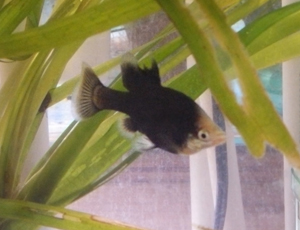
you feel comfortable. Once you become skilled at keeping one species, you can then move to others that may be more
challenging. Once you get comfortable keeping the fish that interest you, then you can learn to breed them. Most fish
found in pet stores, and everything sold here can be bred- figuring out how to produce and raise the fry from those
fish you enjoy can bring in money selling to pet stores, etc. With many fish, the livebearers in particular, you can then
selectively breed your fish, carefully choosing which fish breed based on traits you want to emphasize, creating a line
of fish that are unique to your fishroom!
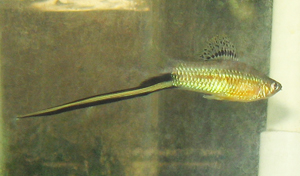
There is a need to keep many of these rarer fish
going, or they will disappear from
the hobby, and possibly from existence. Everyone with a
few pieces of inexpensive
equipment (a tank,
light,
air pump,
box filters and
heater) can provide the best
of
care and contribute to the survival of a species by breeding them and distributing
their fry, if only through local clubs and fish stores.
These species need our attention, and what we do will
establish them for future
generations. Today, there is much help and assistance
out there to ensure that
you are successful. If you have any questions or
concerns, please write me an
email at selectaquatics@gmail.com . Thank you!
Tamosopo. This is a highly desired fish
that is also becoming difficult to find,
and we have doubled the number of tanks
they are in, slowly building up decent
numbers of this fish. After satisfying
wait list customers, they will be listed
as available at the home page as they
are ready to be shipped. If you are
interested in this fish, simply email me
at selectaquatics@gmail.com .
selectaquatics.com
selectaquatics@gmail.com